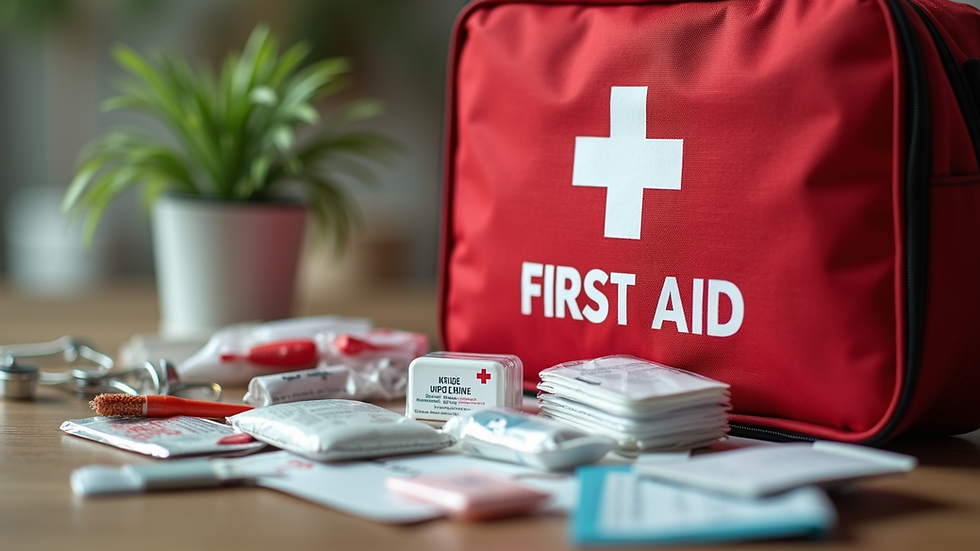Why Every Workplace Needs a First Aid Plan
- Aryeh Goldberg

- Jul 7
- 4 min read
In today’s fast-paced work environments, safety must be a top priority. A comprehensive first aid plan is not just a regulatory requirement; it's a vital component for ensuring employees feel safeguarded and secure. Unexpected incidents can happen at any moment, and being prepared with an effective response can save lives and reduce recovery time. Let's explore why every workplace needs a first aid plan and how implementing one can lead to a safer working environment.
What is a First Aid Plan?
A first aid plan outlines the procedures, equipment, and personnel required to respond effectively to medical emergencies in the workplace. It includes information on how to administer first aid, the location of first aid kits, and the roles of designated first aid responders. A well-structured plan helps minimize the impact of injuries and illnesses that may occur during work activities.

Research shows that workplaces equipped with first aid plans experience fewer workplace injuries and related claims. According to the Health and Safety Executive (HSE), having trained staff can reduce treatment times, leading to quicker recoveries and less absenteeism.
Why Implement a First Aid Plan?
Having a first aid plan in place offers numerous benefits to any organization. Here are several reasons to consider:
1. Employee Safety and Wellbeing
An effective first aid plan prioritizes the safety and wellbeing of employees. Knowing that there are measures and protocols in place provides comfort and reassurance. Employees feel more secure in an environment where their health is taken seriously.
2. Compliance with Legal Requirements
Many jurisdictions require businesses to have a first aid plan and trained personnel. Failing to meet these legal obligations can lead to hefty fines and penalties. Implementing a first aid plan ensures compliance with relevant health and safety regulations.
3. Swift Response to Emergencies
Incidents such as slips, trips, falls, or even allergic reactions can happen without warning. A first aid plan ensures that all employees know how to react in emergencies, promoting a quick and effective response. This not only mitigates the situation but can also be critical in saving lives.

According to OSHA, there is a significant reduction in the severity of medical emergencies when first responders are present within a workplace. Even minor injuries can escalate if not treated promptly.
How many hours is first aid at work?
A common question is, "How many hours is first aid at work?" The amount of training required can vary based on the type of workplace, the number of employees, and potential risk factors involved in the job. Typically, first aid at work training comprises a minimum of 6 hours, often divided into several sessions. These sessions cover essential topics such as CPR, how to treat wounds, and managing shock.
Having trained first aiders on-site not only boosts confidence among the workforce but also ensures that any incidents are handled with professionalism and care.
4. Enhanced Team Morale
A robust first aid plan can promote a positive working culture. Employees are more likely to feel valued and respected when their employer demonstrates responsibility for their health and wellbeing. This increase in workplace morale can lead to heightened productivity and a lower turnover rate.
5. Cost Savings for Businesses
Although implementing a first aid plan may seem like an investment, it can lead to significant cost savings in the long run. By reducing the severity of injuries and the associated medical costs, organizations can save on insurance premiums and potential legal fees. Companies focusing on employee safety often find they have lower healthcare and compensation claims.

Key Components of an Effective First Aid Plan
For a first aid plan to be effective, it should contain several key components:
1. Designated First Aiders
Designating specific individuals as first aid responders is essential. These employees should receive specialized training in administering first aid, CPR, and using the workplace's first aid equipment. Their responsibilities should be clearly defined within the plan.
2. First Aid Kit
Every workplace should have a fully stocked first aid kit. The kit must be easily accessible and regularly checked for supplies. It's important to include items like bandages, antiseptics, pain relievers, and emergency contact numbers for medical services.
3. Training and Drills
Regular training sessions for all employees ensure everyone knows how to respond in emergencies. Practicing drills help reinforce the training and can identify areas for improvement. It's crucial to keep training updated, particularly if new employees join the team.
4. Clear Protocols
Documented protocols detailing what to do in the event of an emergency should be easily accessible to all employees. This includes evacuation routes, emergency contact numbers, and steps to take while waiting for medical assistance.
5. Regular Review and Updates
Regularly reviewing and updating the first aid plan ensures it remains relevant and effective. Engaging employees in this process can help identify potential improvements and encourage a culture of safety.
Final Thoughts on First Aid Plans
In summary, the implementation of a first aid plan in the workplace is not just about meeting legal requirements; it’s about establishing a culture of safety and preparedness. By taking proactive steps, businesses can protect their most valuable asset: their employees. Investing in a thorough, well-structured first aid plan leads to a safer, more confident workforce.
Organizations ready to embrace this essential aspect of workplace safety should consider relevant training options. For further resources and support, you can check out first aid at work programs available for your business.





Comments